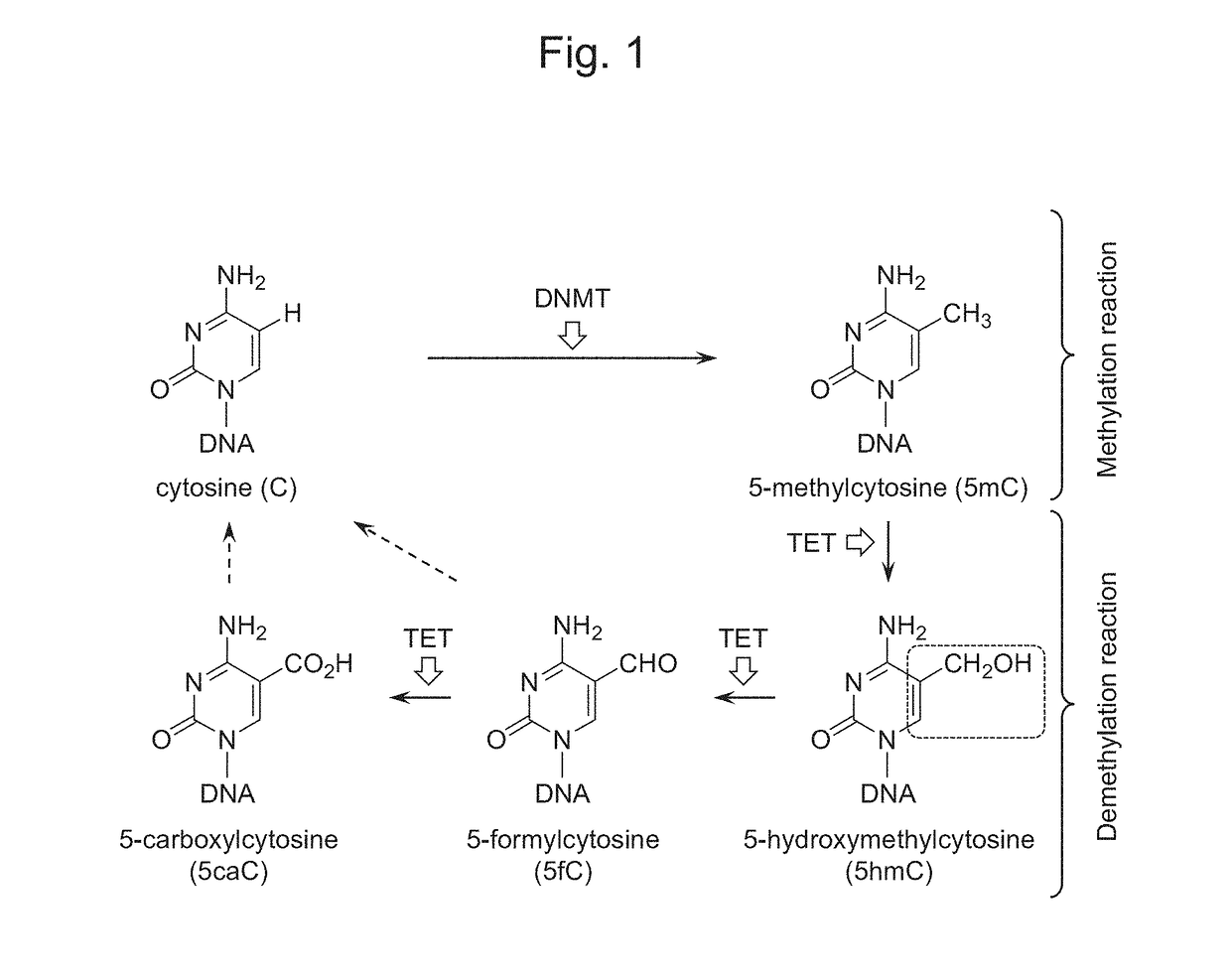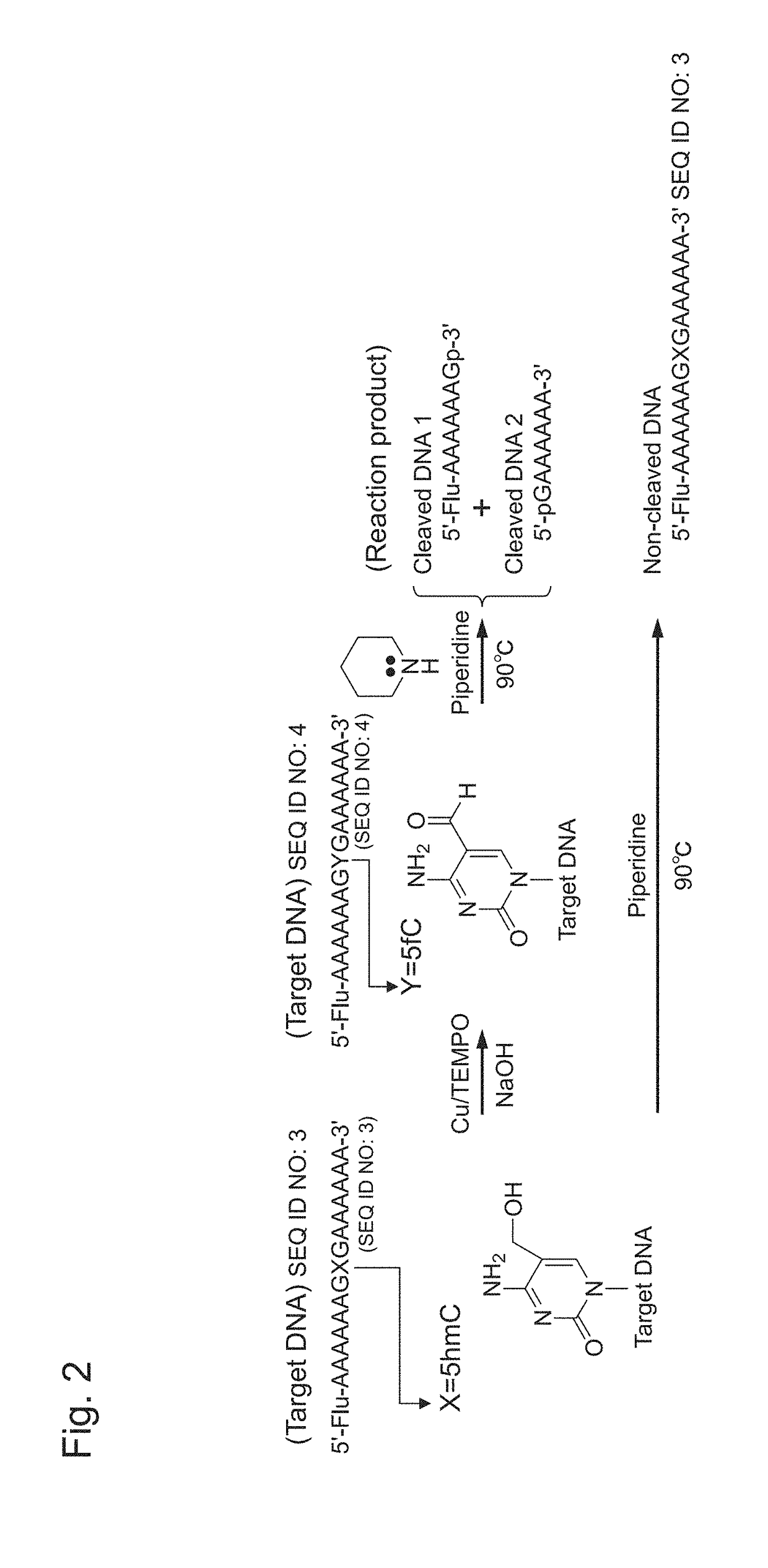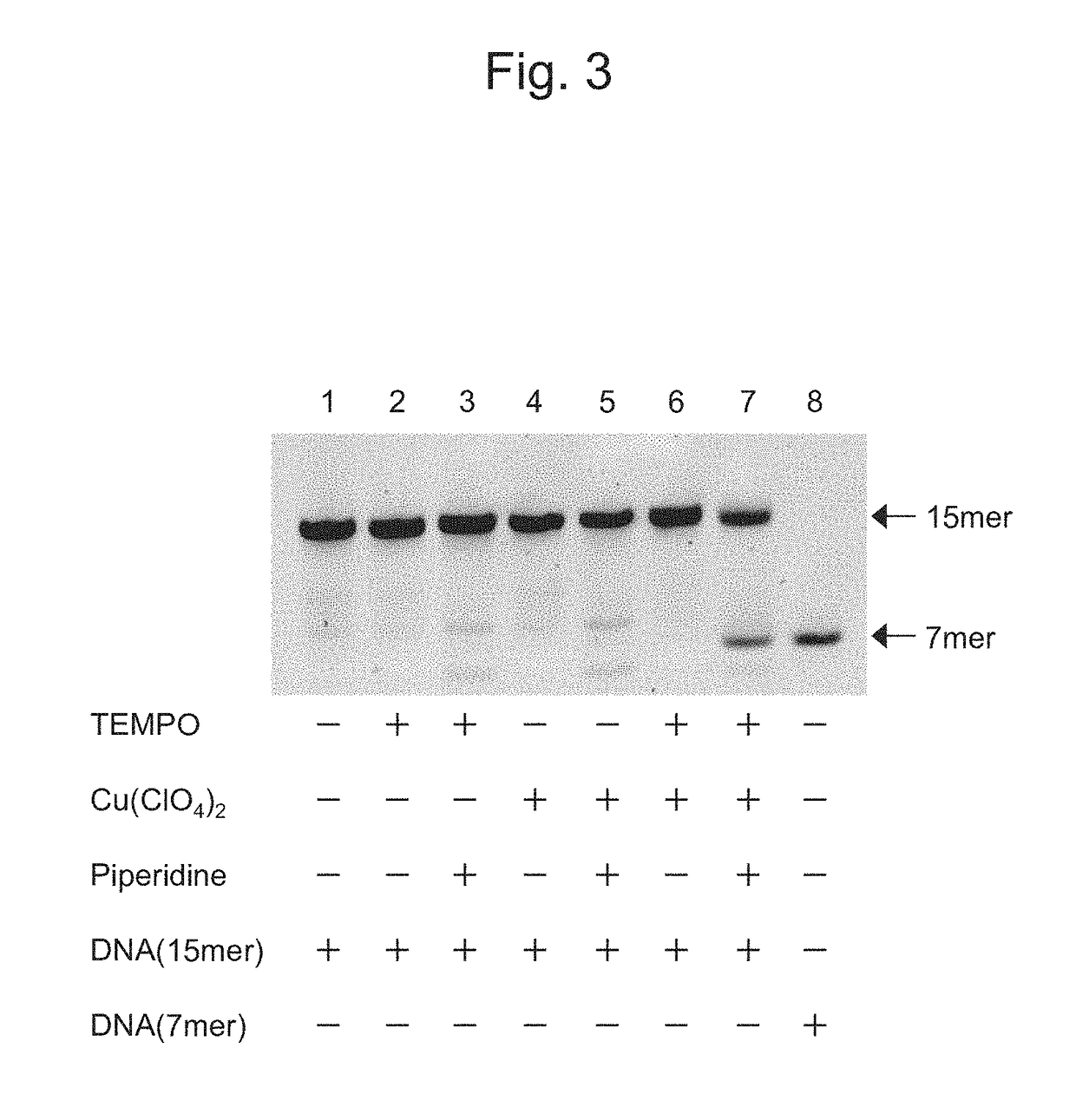Oxidizing agent for 5-hydroxymethylcytosine and method for analyzing 5-hydroxymethylcytosine
a technology of oxidizing agent and cytosine, which is applied in the field of oxidizing agent for 5hydroxymethylcytosine and method for analyzing 5hydroxymethylcytosine, can solve the problems of low accuracy, inability to identify the position of 5hmc in the dna fragment, and the analysis method has not yet been developed, and achieves high accuracy
- Summary
- Abstract
- Description
- Claims
- Application Information
AI Technical Summary
Benefits of technology
Problems solved by technology
Method used
Image
Examples
example 1
(Purpose)
[0105]The reaction in which 5hmC in DNA is specifically oxidized into 5fC by the method of oxidizing 5hmC of the present invention was examined by performing a cleavage reaction using piperidine.
(Method)
[0106]As target DNA, nucleotides consisting of the nucleotide sequence shown in SEQ ID NO: 3 (5′-Fluo-aaaaaaaaagxgaaaaaa-3′; x=5hmC) were synthesized (the synthesis was outsourced to GeneDesign, Inc.). The 5′-terminus of this target DNA was fluorescently labeled with fluorescein.
[0107]Thereafter, 2 μL of 100 μM target DNA (15 mer), 55 μL of MilliQ, 10 μL of 50 mM Cu(ClO4)2, 10 μL of 50 mM TEMPO / acetonitrile solution, 10 μL of 50 mM NaOH, and 15 μL of 50 mM bipyridine / acetonitrile solution were placed in a 1.5-mL sample tube and were then mixed with one another (mixing step). Herein, TEMPO and Cu(ClO4)2 corresponded respectively to a nitroxyl radical molecule and a copper salt, which constitute the oxidizing agent for 5hmC of the present invention. As a control, a sample was ...
example 2
(Purpose)
[0112]Specific oxidation of deoxy-5-hydroxymethylcytidine by the oxidizing agent for 5hmC of the present invention was examined.
(Method)
[0113]As a nucleoside to be examined, deoxy-5-hydroxymethylcytidine (d5hmC) was used, and as a control nucleoside, deoxy-5-methylcytidine (d5mC) was used. A solution containing 17 μM nucleoside, 4.3 mM Cu(ClO4)2, 4.3 mM TEMPO, 4.3 mM NaOH, and 6.5 mM bipyridine was left at room temperature for 1 to 3 days. Thereafter, the solution was 5-fold diluted with water, and was then analyzed by HPLC. In the HPLC, a reverse phase column (Thermo BioBasic-18, 180×4.6) was used, elution was carried out at a flow rate of 1 mL / min, and signal detection was then carried out using 254 nm light. As an eluent, an acetonitrile solution containing 2%-10% triethylammonium acetate was used.
(Results)
[0114]The results of the present example are shown in FIG. 5.
[0115]FIG. 5A shows the results obtained by treating (a) d5hmC and (b) d5mC with the oxidizing agent for 5...
example 3
(Purpose)
[0119]At present, as a method of detecting 5hmC, a method of using a ruthenate is most common. However, this method is problematic in terms of side effects, such that it destabilizes the DNA structure and causes non-specific degradation. Hence, in the present example, the influence of the oxidizing agent for 5hmC of the present invention on the DNA structure, and the related presence or absence of the non-specific degradation of DNA, were examined.
(Method)
[0120]As target DNA, the 15-mer DNA consisting of the nucleotide sequence shown in SEQ ID NO: 3, which was used in Example 1, was used.
(1) Method of Oxidizing 5hmC of the Present Invention:
[0121]2 μL of 100 μM target DNA, 55 μL of MilliQ, 10 μL of 50 mM Cu(ClO4)2, 10 μL of 50 mM TEMPO / acetonitrile solution, 10 μL of 50 mM NaOH, and 15 μL of 50 mM bipyridine / acetonitrile solution were placed in a 1.5-mL sample tube and were then mixed with one another. Thereafter, the obtained mixture was left at room temperature for 1 day....
PUM
| Property | Measurement | Unit |
|---|---|---|
| Temperature | aaaaa | aaaaa |
| Temperature | aaaaa | aaaaa |
| Time | aaaaa | aaaaa |
Abstract
Description
Claims
Application Information
 Login to View More
Login to View More - R&D
- Intellectual Property
- Life Sciences
- Materials
- Tech Scout
- Unparalleled Data Quality
- Higher Quality Content
- 60% Fewer Hallucinations
Browse by: Latest US Patents, China's latest patents, Technical Efficacy Thesaurus, Application Domain, Technology Topic, Popular Technical Reports.
© 2025 PatSnap. All rights reserved.Legal|Privacy policy|Modern Slavery Act Transparency Statement|Sitemap|About US| Contact US: help@patsnap.com



